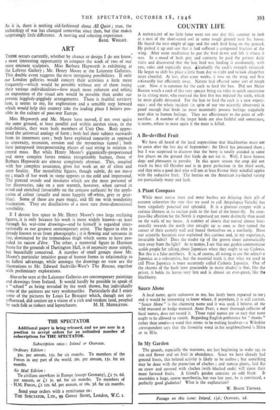ART
THERE occurs currently, whether by chance or design I do not know,• a most interesting opportunity to compare the work of two of our most eminent sculptors. Miss Barbara Hepworth is exhibiting at the Lefevre Gallery ; Mr. Henry Moore at the Leicester Galleries. This double event suggests the most intriguing possibilities. If only our London galleries would concert their activities a little more frequently—which would be possible without any of them losing their various individualities—how much more coherent and telling an exposition of the visual arts would be possible than under our present higgledy-piggledy arrangements. There is fruitful territory here, it seems to me, for exploration and a sensible step forward which would help this country take the leading place I believe pos- sible in the culture of post-war Europe.
Miss Hepworth and Mr. Moore have moved, if not over quite the same ground, at least parallel and within earshot since, in the mid-thirties, they were both members of Unit One. Both appre- hend the universal analogy of form ; both feel their subject outwards from its innermost core ; both have exploited concavity as opposed to convexity, recession, erosion and the mysterious tunnel ; both have juxtaposed interpenetrating planes of taut string in relation to central mass. But while Henry Moore's gigantically-proportioned and more complex forms remain recognisably human, those of Barbara Hepworth' are almost completely abstract. This, coupled with her complete assurance, gives her work an air of silent and utter finality. Her monolithic figures, though subtle, do not move me ;. much of her work in stone appears to me cold and impersonal. The pierced ovoids and involutes which are the most personal of her discoveries, take on a new warmth, however, when carved in wood and enriched (invariably on the concave surfaces) by the appli- cation of colour (usually and more happily off-white, grey or grey- blue). Some of these are pure magic, and fill me with wondering fascination. They are distillations of a most rare three-dimensional sensibility.
If I devote less space to Mr. Henry Moore's two large reclining figures, it is only because his work is more widely known—at least through his war-time drawings—and he himself is regarded inter- nationally as our greatest contemporary artist. The figure in elm is already known to us from photographs ; it is flowing and sensuous in line, dominated by the tremendous thigh which seems to have pro- vided its raison d'être. The other, a memorial figure in Hornton Stone for the grounds of Dartington Hall, is of necessity more simple, but beautifully conceived. A number of- small groups show Mr. Moore's particular intuitive grasp of human forms in relationship, to its fullest advantage, while amongst the drawings on view are the illustrations to Mr. Edward Sackville-West's The Rescue, together with preliminary explorations.
Also to be seen at the Leicester Galleries are contemporary paintings and drawings from Ireland. It would hardly be possible to speak of a " school " as being revealed by the work shown, but individually some of the painters are very workmanlike. Particularly did I enjoy some of the pictures by Louis Le Brocquy which, though not un- influenced, did conjure up a vision of a rich and verdant land, peopled by such folk as tinkers and leprechauns. M. H. MIDDLETON.






























 Previous page
Previous page